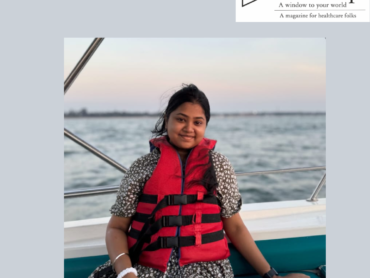Episode 1: Breaking Down the Biochemistry of Medicine
Diagnosis is a documentary series that follows physician and journalist Dr. Lisa Sanders as she crowdsources diagnoses for mysterious and rare medical conditions. In episode 1, we step into the journey of Angel Parker, a young woman caught in the throes of a mystery illness that has shaped her life and limited her dreams since she was just 14 years old. Dr. Lisa Sanders takes us beyond the traditional medical practice by bringing the world into the diagnostic room. This case is not just about finding a diagnosis; it’s about how crowdsourcing, community, and global connection can potentially transform the landscape of medicine.
Step 1: A Life of Pain and the Struggle for Answers
Angel’s life had been plagued by intermittent muscle pains, which often shot from her legs up to her back in waves of sharp, stabbing discomfort. Her pain would often spike after prolonged physical activity, making it feel like her own body was a stranger she couldn’t trust. Visits to the hospital became her norm. At times, her creatine kinase (CK) levels — markers of muscle damage — would skyrocket, signaling to doctors that her muscles were breaking down. They’d hook her up to IV fluids to flush out the damage, and as her CK levels neared 1000, she would be discharged. Each time, however, her time spent in normalcy was short-lived, and the pain would return.
Another important symptom she had was her urine turning a deep cola color, like coffee grounds. This was rhabdomyolysis — severe muscle breakdown into the pigment myoglobin which colored her urine. But after countless hospital trips and tests, Angel was still left without a clear answer. Each visit meant more medical bills and she was swimming in medical debt, with three doctors already having sued her for unpaid bills. The pressure was so crushing that she even considered filing for bankruptcy.
Step 2: Opening Up the Diagnostic Room to the World

Dr. Lisa Sanders knew Angel’s case wasn’t something to solve in a single exam room. Inspired by the idea of democratizing diagnoses, Sanders published Angel’s story and opened her case to the world, inviting anyone — doctors, patients, students, and even people with no medical background — to offer ideas. Sanders hoped this “crowdsourcing” would turn up fresh perspectives that conventional channels might overlook. And it did.
The responses flooded in, offering possible diagnoses that ranged widely: rheumatoid arthritis, lupus, multiple sclerosis (MS), various autoimmune diseases, Lyme disease, McArdle’s disease, glycogen storage disorders, and even CPT II (Carnitine Palmitoyltransferase II) deficiency disease. Each possible diagnosis brought a sliver of hope — maybe one would finally explain Angel’s struggles.
Step 3: A Medical Student in Italy Spots a Potential Match
One response stood out. Marta Busso, a medical student in Turin, Italy, had read Angel’s case while working on her thesis on metabolic diseases. She reached out to Angel with a theory: the symptoms — muscle pain, high CK levels, and cola-colored urine — pointed strongly to either McArdle’s disease or CPT II deficiency, both metabolic myopathies. Unlike traditional muscle diseases, metabolic myopathies interfere with how the body processes energy, and Dr. Sanders agreed that these could be likely suspects for Angel.
Learning about the Italian healthcare system was another revelation. Marta shared that in Italy, genetic testing and metabolic tests are free, especially for patients with rare diseases. Angel, having suffered under the financial burden of the U.S. healthcare system, was astonished at the possibility of testing without incurring even more debt.
Step 4: The Path to Diagnosis

Dr. Spada, the director of pediatrics at Marta’s hospital, arranged for Angel’s metabolic tests. When Angel arrived in Italy, she was both hopeful and nervous, feeling that this moment could change everything. “Finding a diagnosis would change my life completely, and I don’t think I would ask for anything else in the entire world,” she said. Yet, as the first round of tests returned, her metabolic profile came back normal — a disheartening outcome.
Not giving up, the team pursued a second option: genetic molecular testing. Though results would take a couple of months, Angel hoped this would finally lead to the answer she’d been searching for.
Step 5: A Diagnosis and a New Beginning
Two months later, Angel received her diagnosis: CPT II deficiency, a rare metabolic disorder that impedes the body’s ability to break down long-chain fatty acids. For Angel, this was a breakthrough and a new chapter. The Italian doctors advised her to modify her diet, recommending that she increase her sugar intake and decrease fatty acids. They also recommended genetic counseling to determine if she was a carrier, allowing her to plan a family with awareness of her condition’s inheritance pattern.
This diagnosis didn’t just name her illness; it gave her the power to manage it and build a future. Angel’s boyfriend, Mac, captured the significance of this journey when he said, “I feel you guys have started over our lives.” Angel, who had been caught in a cycle of suffering and searching, now had the gift of direction and, perhaps most importantly, relief.
Closing Thoughts
Thanks to Dr. Lisa Sanders’ initiative, Angel received not only a diagnosis but a glimpse into a world where patients, doctors, and everyday people can work together to solve the mysteries of healthcare. Through Angel, we understand how isolating rare and undiagnosed illnesses can be and how much relief comes from connecting with others who can truly understand. Empathy becomes as powerful as any prescription, offering something a patient doesn’t really expect but needs —a sense of belonging.









